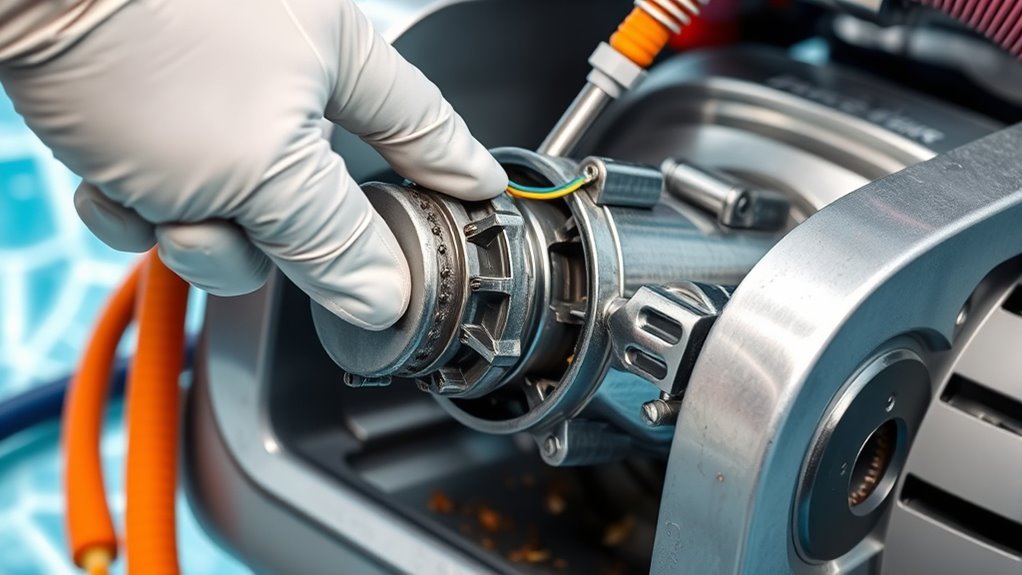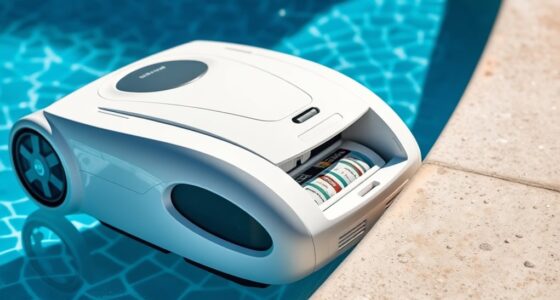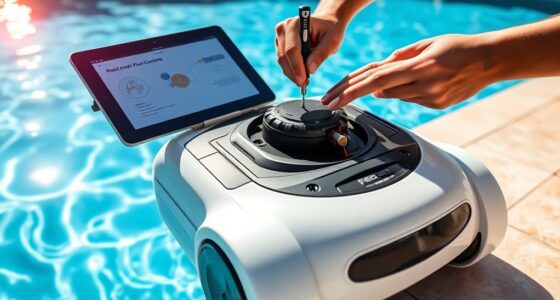If your automatic pool cleaner isn’t working right, start by inspecting and clearing the skimmer and pump baskets to guarantee proper water flow. Check the brushes, tracks, hoses, and connections for debris, cracks, or leaks, and replace any damaged parts. Test the drive motor and verify your power supply and controller settings. Regular maintenance can fix many issues—continue with these steps to uncover more troubleshooting tips that will help restore your cleaner’s efficiency.
Key Takeaways
- Regularly inspect and clean brushes, tracks, hoses, and filters to prevent obstructions and wear-related issues.
- Check electrical connections, power supply, and controller settings to ensure proper operation.
- Examine hoses and mechanical parts for cracks, damage, or misalignment; replace worn components promptly.
- Remove debris from tracks and ensure proper alignment to facilitate smooth movement.
- Perform routine maintenance, including leak detection, electrical testing, and component replacement, for optimal cleaning performance.
Checking and Clearing the Skimmer and Pump Basket

Have you checked the skimmer and pump baskets lately? Clogged baskets can restrict water flow, affecting your pool cleaner’s performance. Before diving into cleaning, ensure the water temperature isn’t too low, as cold water can cause debris to settle differently. Keeping the pool’s chemical balance in check is also crucial; imbalanced chemicals can lead to more debris and algae buildup, clogging baskets faster. Remove debris from the baskets regularly to maintain ideal water flow and prevent strain on your cleaner. Clear baskets help guarantee the pump works efficiently, reducing strain on the entire system. Regular inspections keep your pool cleaner running smoothly and prolong its lifespan, making your pool maintenance easier and more effective. Additionally, understanding pool maintenance best practices can help prevent future issues and keep your system functioning optimally. Ensuring proper filter system operation can further enhance overall cleaning efficiency and system longevity. Properly maintaining the pump and filtration system can also prevent unnecessary wear and tear on your pool cleaner. Regularly checking for clogged hoses can help identify issues early and maintain optimal performance, especially since water flow is critical for effective cleaning.
Inspecting and Cleaning the Cleaner’s Brushes and Tracks

Start by examining the brushes for signs of wear or damage, as worn brushes can reduce cleaning efficiency. Next, check the tracks for obstructions like debris or tangled hair that might hinder movement. Clearing any blockages and replacing worn brushes will help your cleaner work smoothly again. Additionally, inspecting suspension systems can improve the cleaner’s overall mobility and performance. Regular maintenance of mechanical parts is crucial to prevent unexpected malfunctions and extend the lifespan of your pool cleaner. For optimal results, consider consulting brand reputation insights to ensure you’re using authentic and reliable parts. Incorporating essential oil cleaning techniques can also help maintain the cleanliness and longevity of your equipment by preventing buildup and corrosion.
Checking Brush Wear
Since brushes and tracks are constantly in contact with the pool surface, they can wear down over time and become less effective at cleaning. To guarantee ideal performance, perform a wear evaluation regularly. Check the brushes for signs of fraying, cracking, or smoothness—these indicate it’s time for brush replacement. Feel the bristles; if they’re worn thin or uneven, cleaning alone won’t restore their effectiveness. Inspect the tracks for any damage or buildup that might hinder movement. If the brushes are considerably worn or damaged, replace them promptly to maintain thorough cleaning. Regularly assessing wear helps you catch issues early and prevents the cleaner from missing spots or getting stuck, ensuring your pool stays clean with minimal trouble. Additionally, understanding the importance of proper maintenance can extend the lifespan of your automatic pool cleaner and keep it functioning efficiently. Performing routine inspection and cleaning of these components can also help identify minor issues before they escalate into costly repairs. Implementing preventative maintenance practices based on these inspections can further prolong the device’s operational life. Checking the wear of brushes and tracks regularly is a simple yet effective way to avoid sudden breakdowns and costly replacements.
Clearing Track Obstructions
Are debris and buildup blocking your pool cleaner’s tracks? You need to inspect and clean them to guarantee smooth operation. First, check the track alignment; misaligned tracks can cause the cleaner to get stuck. Remove any debris accumulation that might be hindering movement. Regularly clean the brushes and tracks to prevent obstructions. Additionally, inspecting your Mazda B2200 Tuning Interior can remind you of the importance of thorough maintenance and proper alignment to ensure optimal performance. Proper preventative maintenance can extend the lifespan of your pool cleaner and improve efficiency. For best results, consider using air purifiers with HEPA filtration to maintain a clean environment around your pool area. Here are key steps to keep in mind:
- Inspect tracks for debris buildup and remove it promptly
- Realign tracks if they’re out of position
- Clean brushes thoroughly to prevent debris from spreading
- Check for wear or damage that could cause track misalignment
- Verify that the tracks are properly aligned for smooth movement to avoid operational issues
Examining the Hoses and Connections for Leaks or Blockages

To guarantee your automatic pool cleaner functions properly, you need to carefully inspect the hoses and connections for any leaks or blockages. Start by checking the hose connections for tightness; loose fittings can cause suction loss or leaks. Use leak detection methods, such as listening for hissing sounds or applying soapy water to see if bubbles form, to identify leaks. Examine each hose segment for cracks, splits, or punctures, as these can disrupt water flow. Clear any debris or blockages inside the hoses that might restrict movement. Ensuring the connections are secure and free of leaks not only improves performance but also prolongs the cleaner’s lifespan. Regular inspection and maintenance of hoses and connections are essential for smooth operation. Incorporating industry trends and innovative maintenance techniques can help you stay updated on best practices for maintaining your pool cleaner. Additionally, considering Volkswagen Tuning principles, such as optimizing connections for efficiency, can inspire more effective maintenance routines. Taking a proactive approach by routinely testing the system with pressure gauges can further help detect subtle leaks before they become major issues. Employing visual inspection techniques regularly can also catch issues early, saving time and repair costs.
Testing and Troubleshooting the Drive Motor

When your pool cleaner isn’t moving as it should, testing the drive motor is a crucial step. Start by inspecting the motor for visible damage or corrosion. Next, perform electrical testing to check for proper voltage and continuity. If the motor isn’t receiving power or the wiring is faulty, it won’t operate correctly. You can use a multimeter to measure the electrical output and confirm the drive motor is functioning. Additionally, listen for unusual noises or grinding sounds that may indicate internal issues. If the motor fails these tests, it likely needs replacement. Remember, faulty electrical connections or a burned-out drive motor can cause the problem. Addressing these issues promptly gets your cleaner back in action. Proper electrical testing and ensuring the motor is receiving adequate power are essential steps in troubleshooting. Understanding electrical systems can help you identify the root cause more effectively. Regularly inspecting the motor components can also prevent future failures and prolong the lifespan of your cleaner.
Ensuring Proper Power Supply and Controller Settings

A common cause of a pool cleaner not functioning properly is an inadequate power supply or incorrect controller settings. First, check that the power outlet is working by plugging in another device. If the outlet isn’t supplying power, reset the breaker or try a different outlet. Next, verify that the controller settings are correct for your cleaner model. Ensure the timer is set properly and that any power switches on the controller are turned on. If your cleaner has a remote or app, confirm the settings match the manufacturer’s instructions. Sometimes, a simple reset of the controller can resolve issues. Proper power supply and accurate controller settings are essential for your pool cleaner to operate efficiently and avoid unnecessary malfunctions.
Replacing Worn or Damaged Parts to Restore Functionality

If your pool cleaner isn’t working properly, it might be time to check for worn or damaged parts. Identifying these components is key to restoring its performance. Once you spot the issues, replacing the faulty parts can get your cleaner back in action quickly.
Identifying Worn Components
Worn or damaged components are often the culprit behind automatic pool cleaner malfunctions, so it’s essential to examine your unit carefully. Start by checking the brushes, wheels, and hoses for signs of wear or cracks. Look for clogged or dirty filters, as poor filter maintenance reduces cleaning efficiency. Ensure the cleaner’s tracks or wheels turn smoothly, indicating no damage or debris. Also, verify that chemical balancing in your pool isn’t causing buildup or corrosion that can harm parts.
- Worn brushes or tracks that don’t grip surfaces
- Cracked or brittle hoses and seals
- Dirty or clogged filters affecting suction
- Corrosion or buildup from improper chemical balance
Replacing Damaged Parts
When you notice your automatic pool cleaner isn’t working properly, replacing damaged parts is often the quickest way to restore its functionality. Inspect hoses, brushes, and wheels for cracks or wear, and swap out any broken components. Damaged parts can hinder cleaning performance and disrupt water flow, making algae prevention more difficult. Keep in mind, a proper pool chemical balance also supports the cleaner’s effectiveness by preventing algae buildup that can clog or damage parts. Regularly replacing worn components ensures your cleaner operates smoothly and maintains ideal circulation. This simple step not only improves cleaning efficiency but also prolongs the life of your device, saving you time and money on repairs. Always use compatible parts to ensure your cleaner functions at its best.
Frequently Asked Questions
How Often Should I Perform Maintenance on My Automatic Pool Cleaner?
You should follow a regular maintenance schedule to keep your automatic pool cleaner working efficiently. Typically, you should inspect and clean it once a week, especially during heavy usage or after storms. Check the brushes, filters, and hoses regularly, and remove debris to prevent clogs. Adjust your cleaning frequency based on pool usage and debris levels, ensuring ideal performance and longevity for your cleaner.
Can Environmental Factors Affect My Pool Cleaner’S Performance?
Environmental factors can definitely impact your pool cleaner’s performance, like a mischievous wind stirring up trouble. Poor water quality with debris or algae slows it down, making it work harder. Pool shading can also affect how well it cleans, as less sunlight means more algae buildup. Regularly check water clarity and remove debris to keep your cleaner running smoothly, ensuring your pool stays sparkling clean and inviting.
What Safety Precautions Should I Take During Troubleshooting?
When troubleshooting your pool cleaner, safety should be your top priority. Always unplug the device before inspecting or repairing to prevent electric shock. Wear personal protection like gloves and goggles to guard against debris or sharp edges. Keep the power cord away from water, and make certain the area is dry. Following these precautions minimizes risks, keeping you safe while addressing issues with your automatic pool cleaner.
Are There Specific Brands or Models That Are Easier to Troubleshoot?
When choosing an automatic pool cleaner, you might wonder if some brands or models are easier to troubleshoot. Generally, brands with strong customer support and clear manuals tend to have fewer model-specific issues and better compatibility. Look for models known for user-friendly design and reliable parts. Research reviews to identify which brands offer easier troubleshooting, and always make certain of compatibility with your pool’s size and type for smoother maintenance.
How Do I Identify if a Problem Is Electrical or Mechanical?
Imagine you’re in a sci-fi movie, but the real mystery is your pool cleaner. To tell if a problem’s electrical or mechanical, start by checking for electrical issues like blown fuses or loose wiring. If power’s fine, look for mechanical failures, such as jammed wheels or damaged brushes. Electrical problems usually cause the cleaner to not start at all, while mechanical issues may make it move strangely or stop.
Conclusion
Think of your pool cleaner as a trusted companion that keeps your pool sparkling. When it stalls, it’s like a friend lost in the fog—you need to clear the path. By checking each part, you’re guiding it back to clear waters. With patience and a little troubleshooting, you’ll restore its rhythm, ensuring your pool stays inviting and pristine. Remember, a well-maintained cleaner is the key to endless summer days of invigorating dips.









